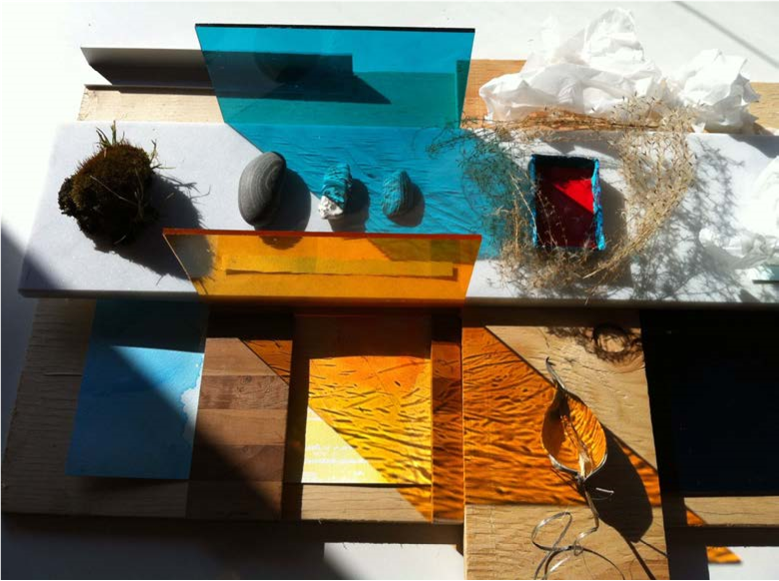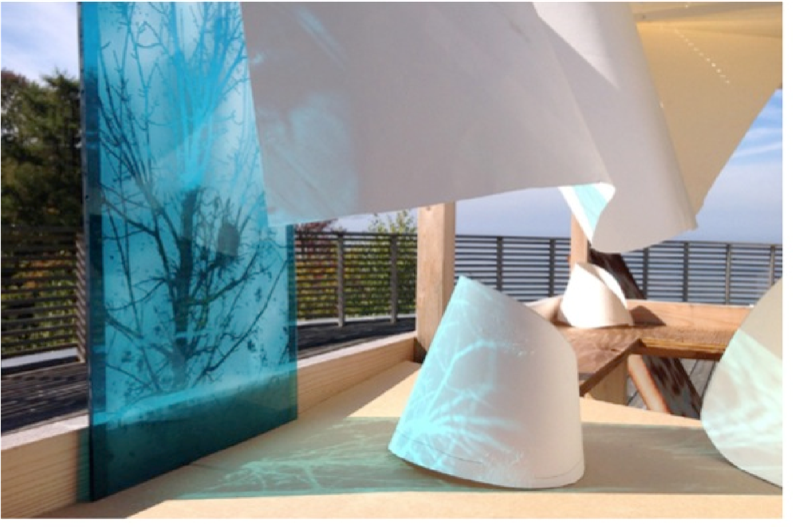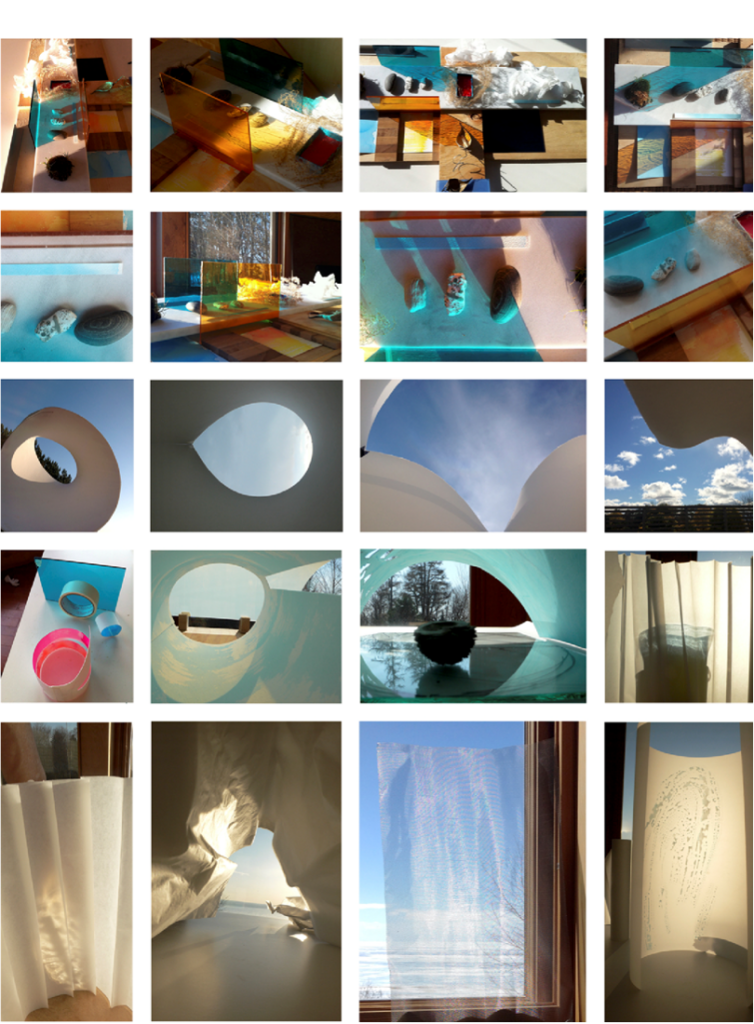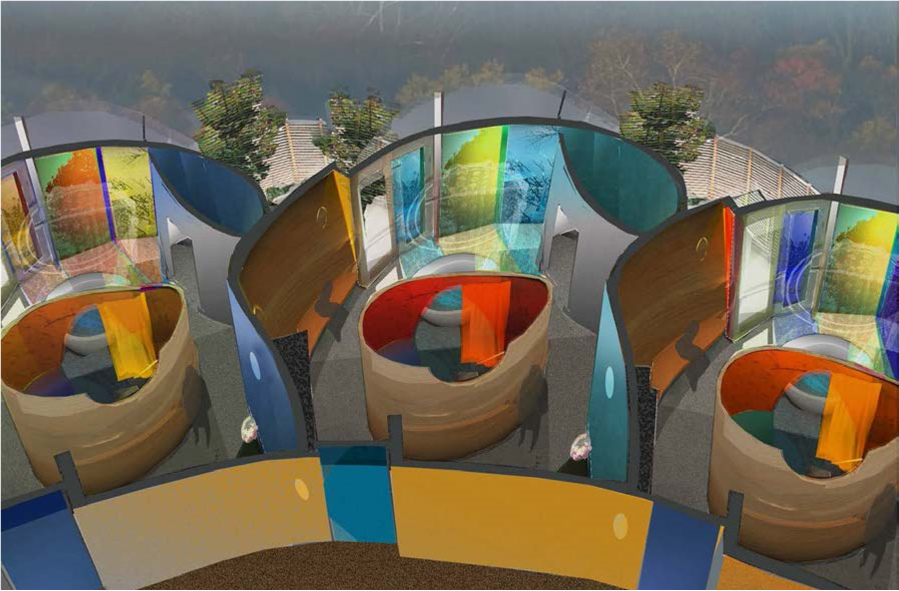Doreen Balabanoff
OCAD University, Toronto, Ontario, Canada
dbalabanoff@faculty.ocadu.ca
Summary
It has been suggested that architecture has its roots, its earliest manifestations, in the cave, the forest clearing, and/or the primitive hut.[1]The act of giving birth – profound yet ordinary – also has for millennia been affiliated with protective places made by nature or modeled by humans. What is the import of this first space of our entry to this world? Contemporary society understands the labor and delivery room as a medical space, where risk and safety are the key concepts at play, and fear is the dominant emotion.[2] My doctoral study, sought an intersection and harmony between theory and practice that could engage the sacred nature of this environment. Goethe’s practice of phenomenological knowing comes closest to my approach to practice-based research and discovery, but I am more interested in the interwovenness of diverse ways of knowing than I am in dwelling within the bounds of any single theory.[3] Transdisciplinary ontology offered me a way to engage in pondering the nature of birthspace as a values-driven, multi-perspectival praxis – a praxis in which poetic consciousness is valued as revelatory.[4] In writings on light by Maurice Merleau-Ponty and James J. Gibson I found a strong consilience, in alignment with my own explicit and tacit artistic knowledge (working with glass, color, light in spatial settings).[5]
Diverse architectural, cosmological, ecological, atmospheric and aesthetic understandings of light were engaged throughout my experimental process, and emergent design work led to a conceptual distillation of six key points concerning the role of natural light in developing an environment of embodied sentience supporting salutogenic and spiritually resonant birth experience. These points are transferrable concepts (with detailed description for practice) that facilitate a better birth experience while allowing flexible responses to climate, geography, culture and creative voice. This project builds upon the work of others who seek to challenge the medicalized model of birth environment, by focusing on natural lightas a key means of creating sensual, emotive atmosphere. The project offers a detailed architectural understanding of light that develops spiritually sensitive experience…going well beyond ‘white’ light, and including surfaces, substances, ether and cosmos in its purview. I offer this work in hopes that other architectural designers will find this work meaningful, and take up the collective work of advancing this paradigm shift towards a new architecture for birth.
Thesis
Light is the primary force of lifegiving. It gives joy, it gives spirit, it illumines both meaning and being. “Let there be light” is the first act of creation in the Genesis story. Without light there is no life, yet in the very sacred theatre of life’s emergence, the birth room, light is mechanical. Its range, nuance, harmonies and glories are diminished to the thin realm of minimum utility. My thesis addresses this paucity and reimagines a new paradigm for birthspace where light reveals, celebrates and surrounds this sacred act of passage. Natural light, the invisible ubiquitous energy made visible/tangible by matter in all its forms, is at the heart of my inquiry, and is understood as the inseparable phenomenological trio of light-color-darkness.
Introduction
As a woman who has given birth twice in (different) hospital settings which I found sub-optimal, and as an artist and designer whose interest in and study of light in architectural space has spanned more than thirty years, I felt both the need and the capacity to fuse these two realms into a synergistic praxis. A practice-based doctoral study was the result, taking up the complex question of how we might, as artists, architects and designers, significantly reimagine the birth environment. Today, birthspace seems to be calling out for transdisciplinary, transformative thinking that could ‘unconceal’ new understandings and emergent possibilities for a radical shift in its nature.[6] This shift is needed because of a global ‘polycrisis’ in birth culture as understood from multiple standpoints (feminist, post-colonial, salutogenic, and phenomenological, spiritual). The “impact that the birth environment has on the childbearing woman and her baby, and by extension, all families and all communities,” is recognized in global discourse, but this space/place is not yet being taken up as an architectural arena that provides tremendous opportunity for contributing to human flourishing through sensitive, experientially driven architectural attention, knowledge and effort.[7]
My project sought to transcend the medicalized, ‘technocratic’ model of birth and its birth setting. It developed from awareness that the emotional/spiritual experience of the environment is implicated in the situated and fluctuating embodied interrelationships between the mother and child, and all who are involved/present. It sought a new paradigm – a new architecture for birth privileging attunement of light as a key to heightening the power and meaning of birthspace as a primary, primordial, spiritual place of being/becoming.[8]
Context/Frameworks
In 2008, midwifery practitioners/researchers Kathleen Fahy, Maralyn Foureur and Carolyn Hastie set out the specific theoretical foundation upon which my thesis builds. Their ‘Birth Territory’ framework built upon the work of others and is important to the re-invention of birthspace.[9] It led directly to a much-needed tool for assessing birthspaces, as a step towards making change, and as a grounding for others who have built upon their work.[10] Fahy et al noted: “there is a paucity of theory or research on the effect of environment on birthing” and stated: “the theory of birth territory challenges the medical theory of birth which views women’s bodies as if they were unreliable machines.”11
As a voice from the field of architecture, Bianca Lepori has been a strong and original proponent of the need to re-invent birthspaces. Her writings, along with those of obstetrician Michel Odent’s and anthropologist Sheila Kitzinger’s, have provided significant insights into attributes and affordances of birth environment that are important for ‘normal birth’ support.12 While these researchers all synthesize knowledge from numerous fields, the mind/ body connection is often mentioned in their work. Within natural physiological (mammalian) birth processes, neurohormones are understood as vital to birth processes – and are responsive to environmental factors.13 Knowledge of the role that the hormone oxytocin plays in birth makes it clear that the birth environment itself can enhance or diminish oxytocin release in the body, facilitating or slowing down birth processes. This knowledge is foundational for my project. In addition to Kitzinger, anthropologists Brigitte Jordan and Robbie Davis-Floyd have provided insight into historical and cultural aspects of birth, understood as a human rite of passage.14 Their work addresses how women across the globe have been impacted by the shift of authority in birth practices. Midwife/researcher Susan Crowther has noted that: “[t]he environment of birth enables or disables the availability of spiritual experiences to unfold for all those there…[as] the birth place (i.e., physical birthing room) holds significance and meaning for all involved.
The Project
My study sought tangible, transferrable ‘poetic disclosures’ that could contribute to a deepening awareness of the needs and desires that a reimagined architecture for birth might support and satisfy. The methodology utilized here fits the model of exploratory process described by Pérez- Gómez as “[p]laying with materials and modalities of representation, deliberately disturbing the presumed linearity of planning in a design task.”15
Three informing positions – 1) transdisciplinarity, 2) the valuing of natural or ‘normal birth’ approaches and 3) phenomenological inquiry through artistic ways of seeing/knowing/doing – clarified the values and approaches brought to this architectural study for birthspace. These positions anchored the fundamental methodology: heightened and prolonged attention to phenomenological and sensory/emotive aspects of space/place. The project unfolded in distinct phases; 1) a literature review on birth and birth environment; 2) a first round of studio explorations, accompanied by documentational and reflective processes; 3) an Artificial Sky lab experiment; 4) a second round of studio/design exploration (interior/exterior); 5) an in-depth study of writings of Merleau-Ponty and Gibson on Light; 6) a look back at my own previous works, mining my own (often tacit) knowledge built up over time; 7) a third round of collaborative) studio work including digital modeling; and 8) a final development, from this work, of a set of principles or concepts providing new insight for a paradigm shift in birth environment design.
Through this iterative studio process, I developed a prototypical birthing room (using both physical and digital modeling), allowing the process to lead me in testing and finding potential solutions. Crafting a specific birthspace seemed important not as a perfect ‘final product’, but as a means of slowly consolidating key concepts. The Goethean observation that “color is already a degree of darkness,” when combined with Gibsonian and Merleau-Pontian insights and my own deep practice-based knowledge, led me to articulate that natural light could be understood as the inseparable trio light-color-darkness. Emergent themes from the study of my own previous artistic practice included: 1) Image and Emanation 2) Resonance and Chord 3) Threshold and Veil 4) Projection and Reflection.[11]The interrelationship of light and material, of the synaesthetic nature of spatial experience, was now fully present in my design work. The light provided the connection, the continuity, between the form of the architecture and the body of the birthing woman. With the formative relationship between the architecture and the experiences of the birthing woman, child and their companions/caregivers in mind, I developed a modular unit that worked to create an organic whole, but one that left rectangles behind. In the final birthing room, the key principles others had articulated were included, but light had become in itself a guiding principle for mindbody-environment engagement in and through architectural space-form-time. It became manifest everywhere, in diverse ways.
Light thusemerged through my studies as an aspect of birth environment design that was not yet adequately valued, though it seems obvious. Whether seeing sunrise or sunset, a blue sky or a cloudy or stormy one, there is a connection to cosmos that is given by natural light and its constancy but ever-changingness. But there is also an emotional resonance given by the tremendous range of light-color-darkness, both physical and ephemeral. Providing a view out returns one to the universal – sky, garden, birds, clouds, and the cyclical nature of life – seasons, storms, blossomings, water flowing, the world quickening in spring, the ripeness of summer fruit, the austere beauty of winter. Everywhere, these associations are different, but similar. The threshold between inside and out can mediate and make manifest the aliveness caused by the passage of the sun or moon through the day or night. Thus a window is more than a view, it lets light in all its powers engage our embodied senses. Birth centers and birth rooms could and should provide these affordances for pleasure, sensuality, flow, exhilaration, joy, aliveness. ). Supporting more natural, less medicalized birth practices and experiences requires a model of birthspace that alters the consciousness of all who enter.
These thoughts and processes begin to answer the question,
How can Light (light-color-darkness) as a key element of phenomenological architecture be sought and found using embodied design processes (from embodiment to embodiment) to find an emergent new architecture supporting a more positive, embodied, lived experience of birth?
The new paradigm I am seeking is architectural. By this I mean that it is more than a programmatic list of functionalities and economic restrictions – more than a space-planning concept. The ideas that emerged through the work have been sifted and sorted into six main points, outlined below. These points are offered as conceptual and phenomenological architectural principles related to light as a foundational aspect of a new architecture for birth.
Conclusions:
Six Points for Reimagining Birthspace Design:
1. Facilitate Awareness of Cosmos using Lateral and Zenithal Openings for Light
Make connection to Cosmos, Place and Time a priority. Orient to Cardinal directions. … heighten connectivity to the world writ large, that is, to the universe itself. This cosmicity can contribute to memorable, meaningful birth experience… Design for opening – for exhilarating views to sky/weather and visibility of cycles of sun and moon.
2. Enhance the Phenomenological Interplay between Light and Surface
Design apertures and surfaces as interrelated, to enhance the capturing of light and the play of light, and to make the material aspects of surfaces more sensually present. Maximize delight in the relationship between light and materiality.
3. Make the Threshold between Inside and Outside Experientially Rich
Design for privacy/enclosure and views through – allowing the inside and outside conditions of light and space to be contrasted. Create veils or screens that play with opacity and transparency, shadow and light, view through and view of the surface/threshold itself.
4. Develop Modulation and Gradation of Light for Sensual Flow
Use gradation and gentle fades of light to dark value to create a sensual state of flow in the space. Create…differentiated spaces using flow and gradation between lightness-color-darkness to create differences in spatial ambience and privacy levels…to create emotive atmosphere, and a sense of flow, which relaxes muscles and creates calm.
5. Use Color to Create Vividness and Depth
Consider color as materiality and as light. Consider it as resonance.
Balance vividness with calmness and depth. Let light highlight and deepen the color. Consider color as resonance that creates atmosphere. It fills the air. It permeates the body.
6. Develop Spatial Aliveness through Use of Light
Consider aliveness as a core quality of an architecture for birth…
Make the movement of air and light visible to make the aliveness of the world visible in birthspace. Direct the viewer’s attention – inside and out – to places where movement of air and water occur. Design ways to showcase light’s interaction with moving air and water – the play of light-shadowrefraction-reflection – to make the aliveness of these elements a part of the spatial atmosphere.
In these concepts, not foreign to architects, but completely absent from most birthspaces, light, in all its architectural capacity is articulated as a powerful affordance for supporting and enhancing natural birth processes – and pleasurable, even exhilarating birth experiences…for creating sensual birthspace that viscerally connects us to that ‘third’ (elusive, embodied, ‘aesthetic’) aspect of architecture, Venustas…literally the properties of Venus…the embodied energy of love, beauty, sexuality, fertility, prosperity, victory and desire. Reimagining the role of light-colordarkness in birthspace may be understood as a means of shifting the paradigm to include Venustas in the emotional resonance, aliveness and temporality of birth…to create birthspace dedicated to honoring the sacredness, beauty and meaningfulness of being born and giving birth.

Initial Concept Model (detail) (above) and Rooftop Experimentation (below)


Images from various studio explorations: light, layer and space
Birthing room modules: interior spatial atmosphere, privacy, ambulatory, bathing and terraces (below)

[1] Marc Antoine Laugier. Essay on Architecture (Los Angeles: Hennessey and Ingalls, 2009); Vitruvius.
The Ten Books on Architecture, trans. Morris Hicky Morgan (Cambridge: Harvard University Press,1914).
[2] Sheena Byrom and Soo Downe. Introduction to The Roar Behind the Silence, ed. Sheena Byrom and Soo Downe (London: Pinter and Martin, 2017).
[3] David Seamon and Arthur Zajonc (eds.). Goethe’s Way of Science: A Phenomenology of Nature (Albany, NY: SUNY Press); Alberto Perez-Gómez. Built Upon Love: Architectural Longing after Ethics and Aesthetics (Cambridge: Mass: MIT Press, 2006).
[4] See Sue McGregor, Demystifying Transdisciplinary Ontology (Integral Leadership Review, 2011).
http://integralleadershipreview.com/1746-demystifying-trandisciplinary-ontology-multiple-levels-of-realityand-the-hidden-third [Accessed April 20 2019].
[5] See Doreen Balabanoff. “Chapter 2 Merleau-Ponty and Gibson: Insights” in Light and Embodied Experience in the Reimagined Birth Environment. (Doctoral Dissertation University College Dublin 2017) 64-118.
[6] Ibid, 1-62.
[7] Kathleen Fahy, Maralyn Foureur and Carolyn Hastie. Preface,” in Birth Territory and Midwifery Guardianship, ed. Fahy, Foureur and Hastie (Edinburgh: Elsevier, 2008), ix-x.
[8] Susan Crowther and Joanna Wojtkowiak. “Contrasting Spirituality at the Beginning and End of Life,” Spirituality in Clinical Practice, Vol. 5, 2018.
[9] Fahy, Foureur and Hastie. Birth Territory and Midwifery Guardianship. See antecedent work from Ellen Hodnett (Canada); Denis Walsh (UK); Mary Newburn and Debbie Singh (UK); Michel Odent (UK); Bianca Lepori (Italy); Sheila Kitzinger (UK).
[10] See for example the many journal articles by Maralyn Foureur and collaborators (incl. 2008, 2010, 2011) related to the BUDSET project; also J. Davis Harte. “Perspective: The Influence of Birth Room Design on Maternal Stress, Neurohormones and Attachment,” in Environmental Psychology for Design,
[11] see Doreen Balabanoff. “An Artistic Praxis: Phenomenological color and embodied experience,” JAIC Journal of the International Colour Association ed. Verena Schindlervol. 17 (2017). Available at aiccolor.org/page-18069. [Accessed April 29, 2019].
12 Bianca Lepori. La Nascita I Suoi Luoghi. Milano: Red Edizioni; Bianca Lepori. “Mindbodyspirit Architecture: Creating Birth Space” in Birth Territory and Midwifery Guardianship (2008); Michel Odent.
The Nature of Birth and Breastfeeding (Westport: Bergin and Garvey ,1992); Sheila Kitzinger. Rediscovering Birth (London: Pinter and Martin 2000).
13 Uvnäs Moberg. Tapping the Hormone of Calm, Love and Healing. Cambridge, MA: Da Capo Press (2003). See also Newton (1958,1987,1990); Newton, Foshee and Newton (1966).
14 Brigitte Jordan. Birth in Four Cultures (Montreal: Eden Press, 1978); Robbie Davis-Floyd. Birth as an American Rite of Passage (Berkeley: University of California Press, 2004).
15 Alberto Pérez-Gómez. Built Upon Love: Architectural Longing after Ethics and Aesthetics (Cambridge, MA: MIT Press, 2006), 210.



